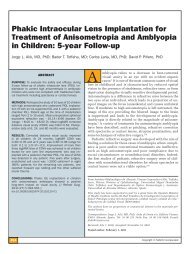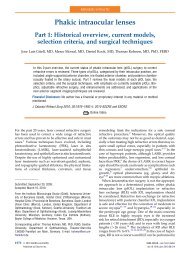PHAKIC FUTURE - LaserMed
PHAKIC FUTURE - LaserMed
PHAKIC FUTURE - LaserMed
Create successful ePaper yourself
Turn your PDF publications into a flip-book with our unique Google optimized e-Paper software.
14 OPHTHALMOLOGY WORLD REPORT DECEMBER 2007 SUPPLEMENT<br />
15<br />
dominant eye at the target refraction, with residual myopia,<br />
and have them wear it for a while. We can always do LASIK<br />
on the eye if we leave residual and they don’t like it, but that<br />
is an extra cost. If I were doing this with a LASIK patient,<br />
I’d be a little more lenient. But with ICL patients I insist<br />
that they first try out the monovision target refraction with a<br />
contact lens.<br />
OPTIMAL PATIENT<br />
World Report What’s your optimal patient for the ICL?<br />
Dr. Chang The studies are now showing that the younger<br />
patients are less likely to develop cataract. The youngest<br />
patient I’ve done was 20, and I’m quite comfortable doing<br />
younger patients. When I first started I focused more on<br />
older patients, the almost 40s. The concern is that in very<br />
young patients the eye is still growing longer, so we want to<br />
see stable refraction for at least one year. If it’s a patient I’ve<br />
been following for some time, I won’t insist on one year.<br />
I’ll accept 6 months. But if it looks like they’ve progressed,<br />
I’ll definitely wait another six months.<br />
LEARNING CURVE<br />
World Report Dr. Vukich, how important is skill to the ICL’s<br />
safety and stable performance?<br />
Dr. Vukich There’s no question that skill plays a role. You<br />
want to practice state-of-the-art ophthalmology, but this really<br />
isn’t just for the extremely gifted and talented surgeon.<br />
Any surgeon who is comfortable in the anterior segment is<br />
absolutely capable of doing a very fine job with this lens.<br />
World Report Dr. Chang, how would you describe the ICL<br />
learning curve?<br />
Dr. Chang I think it’s more of a mental issue than surgical.<br />
We’re all cataract surgeons. We are all used to working in<br />
narrow spaces. But to have that dilated pupil, and the endothelium<br />
right there. I always say it’s like working between the<br />
devil and the deep blue sea. You go one direction and hit the<br />
endothelium; you go the other and you hit the lens. It can be<br />
scary. But having said that, it’s really not that difficult. Once<br />
you get over the mental block, and just get in there and be<br />
careful, it’s really much easier than you’d expect. My average<br />
case now is maybe 7-10 minutes.<br />
BRIDGING CATARACT<br />
& REFRACTIVE<br />
World Report What are the implications of the comparison<br />
studies for our 17,000 readers in China and 10,000 in<br />
India—countries with 1 billion-plus people and huge gaps<br />
between rich and poor?<br />
Dr. Sanders Not everyone can afford an excimer laser. The<br />
cost of the ICL is that the doctor has to learn how to put it<br />
in, but it’s not a volume issue. In the developing world if you<br />
want to buy an ex-cimer laser you have to know you can do<br />
600-800 cases a year to amortize the cost. With the ICL fixed<br />
costs are minimal. Another problem is service. In China or<br />
India if you are away from a big city, getting your laser serviced<br />
may be a problem. The ICL is a lens. You put it in and<br />
you’re done. It’s not capital intensive.<br />
World Report Isn’t this technology putting a much higher<br />
level of refractive accuracy in the hands of cataract surgeons,<br />
enabling them to start acting more like refractive surgeons?<br />
Dr. Vukich That is a global trend. Cataract surgery is refractive<br />
surgery, and it always has been. Our patients not only<br />
want improved vision, they want freedom from glasses as an<br />
expected result of cataract surgery! Given the opportunity to<br />
lose their glasses, people will come to expect that as a result<br />
of cataract surgery. The universal goal will be not just to<br />
remove the cataract but to leave the patient spectacle free.<br />
World Report In China there’s still a cataract/refractive firewall.<br />
Refractive surgeons can do LASIK all day long, but few<br />
do intraocular surgery. How should they view the ICL?<br />
Dr. Chang Refractive surgeons should not completely separate<br />
themselves from cataract surgery. You don’t have to be<br />
a volume cataract surgeon to be an ICL surgeon. If you do<br />
one or two cataracts a week it’s enough, though if you are a<br />
high-volume cataract surgeon, it’s easy. This firewall has to<br />
come down. We now also have multifocal IOLs. People in<br />
the presbyopic age who are myopic will probably do better<br />
with a refractive lens exchange than with LASIK. Nowadays,<br />
I’ve begun moving about 10% of my LASIK patients over to<br />
the lens exchange group. I just did a patient who was -31D<br />
of myopia, functionally blind. I put in a multifocal and the<br />
patient came back 20/25 uncorrected. I’ve moved a lot of my<br />
bioptics patients over to clear lens extraction. This firewall<br />
has to come down because the lines are really blurring between<br />
cataract and refractive.<br />
World Report Dr. Vukich, where do you see the balance?<br />
Dr. Vukich Let’s say, for sake of argument, that the risk is 5%<br />
in someone who is -20D. You can turn that around and say<br />
that 95% of the time you are going to have a patient who is<br />
absolutely thrilled with an excellent quality of vision. One<br />
out of 20 times there is a possibility that they may require a<br />
lens extraction that still will leave them emmetropic; cataract<br />
surgery is well within the skill set of these surgeons who are<br />
capable of using these implants. So rather than do a refractive<br />
lens exchange or clear lens extraction in the first place,<br />
you’ve got a 95% chance of having an out-standing quality<br />
of vision. And if it turns out that there something more than<br />
needs to be done, the solution is readily available and executable<br />
by the same surgeon and it will lead to the patient being<br />
where they wanted to be anyway—with good emmetropic<br />
vision—by doing cataract surgery with an implant. We don’t<br />
want that to be the case in a high percentage of patients, but<br />
the fact is, if it’s a problem that can be readily addressed and<br />
fixed, it’s not as big a problem as if you have corneal instability<br />
or ectasia or intractable night glare or other problems<br />
that you’d get with high myopic LASIK treatment. Yes, it’s a<br />
problem but it’s a problem that can be fixed.<br />
World Report What’s your advice for the refractive surgeon<br />
who doesn’t do much cataract?<br />
Dr. Vukich This is a challenge. Keeping your intraocular skill<br />
set current requires that you work inside of the eye at some<br />
frequency. Anyone who is trained to work inside the eye<br />
can quickly reestablish that comfort level. But if you haven’t<br />
worked inside the eye for several years, having concentrated<br />
primarily on LASIK, it’s going to feel awkward going back<br />
in. Probably the biggest challenge for the LASIK-only surgeon<br />
is that they may not have a readily available intraocular<br />
surgery suite. We do these lenses in the same setting as<br />
cataract surgery—a clean, sterile environment for intraocular<br />
procedures. One of the beauties of the ICL is that if you do<br />
cataract surgery, you already have an operating room ready,<br />
you have a routine where you are in the eye anyway. The ICL<br />
can just flow right in.<br />
POSITIONING IN PRACTICE<br />
World Report Dr. Sanders, what do you see as the practical<br />
implications of these studies?<br />
Dr. Sanders The people who have been doing these studies,<br />
whether it’s Dr. Vukich and Dr. Schallhorn, do<br />
a lot of LASIK. They have no particular reason<br />
to want the ICL to look better, given that their<br />
practice is mostly LASIK, not ICL. We are not<br />
saying that the ICL should replace LASIK. But<br />
we are saying it should be an active consideration<br />
in every patient who falls within the range of its<br />
approval status. Phakic IOLs in general are an<br />
excellent option because you don’t have to worry<br />
about healing as a part of the equation. You can<br />
get more accuracy and more predictability. It’s a<br />
faster procedure. In LASIK, wound healing gets<br />
in the way.<br />
World Report Some US surgeons are saying<br />
you need to cannibalize your LASIK practice to<br />
build your ICL practice. Dr. Chang, are you in<br />
that camp?<br />
Dr. Chang Financially, LASIK is better for<br />
me than ICL. I do ICL as a service. It’s a great<br />
lens and works very well, but if you are talking<br />
about cost-wise, both for the patient and the surgeon, at least<br />
in my practice, LASIK is more cost-effective. Putting cost<br />
aside, with the ICL you don’t have to worry about regression.<br />
The quality of vision is better. If the patient is not concerned<br />
about cost, ICL is the way to go. For India and China the<br />
cost factor will be the major issue. Ironically, as you get out<br />
into the countryside, the need for the ICL is probably greater<br />
because of the issues of glare and halo, but the affordability<br />
becomes a major issue. It definitely makes sense to add ICL<br />
if you have a patient base that can afford it.<br />
World Report Do you market the lens?<br />
Dr. Chang Hong Kong is quite conservative and we are not<br />
allowed to market, but I’ve been using the ICL for about five<br />
years and I’m starting to get good word of mouth business.<br />
This year I expect my ICL volume will have doubled. It’s<br />
a simple fact that more patients have done it and they refer<br />
their friends. It’s definitely a workhorse lens in my practice.<br />
World Report Dr. Vukich, are you in the cannibalization<br />
camp, promoting ICL over LASIK?<br />
Dr. Vukich The right word is not cannibalize, but supplement.<br />
They are synergistic and grow one another, and you develop<br />
a reputation of providing excellent quality of care. Patients<br />
don’t want LASIK and they don’t want an ICL. They want to<br />
see better. Once you change your focus to say, OK, we are going<br />
to provide you with the best quality of vision and here are<br />
the different options and tools we have to achieve that goal,<br />
we are going to customize our selection based on what your<br />
needs are, that really grows the practice. People come to know<br />
that you are not just a LASIK surgeon. In fact, my LASIK<br />
practice has grown as we have continued to offer the ICL.




